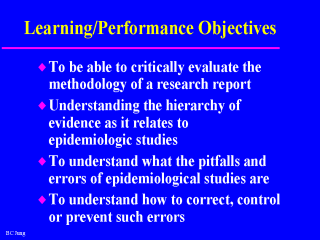 |
This lecture seeks to
provide you with some basic principles of reading research reports with a critical eye. It
also seeks to tie together some of the more peripheral issues that have arisen in the
course of developing these lectures. The sequence of this series of lectures started
off broadly, then concentrated on specific areas of Epidemiology. Now, as this series
comes to an end, it is time to bring everything together again, within a broader context.
This, and the next lecture, seek to explore some of the weaknesses and current issues of
epidemiologic studies and methods, and the strategies that can be taken to correct these
weaknesses. They also provide you with tips on what to look for in a good research report.
It is my hope that these two lectures will help you understand how to best use the
findings of epidemiologic studies.
Sources for this lecture include WHO (1993), Basic
Epidemiology; RM page, GE Cole & TC Timmreck, Basic Epidemiology Methods and
Biostatistics; HRSA (1998) Analytic Methods in Maternal and Child Health; M. A.
Patton (1990) Qualitative Evaluation and Research Methods; T. Greenhalgh’s
lectures at: http://bmj.com, and V.H. Massey (1991) Nursing Research. A study and
learning tool. |
